
Between 2003 and 2017, Venezuela and China entered into a $22 billion investment agreement to develop 17 projects that would generate power, interconnect the country with trains, build housing, launch a satellite into space, manufacture household appliances, process rice, carry water into thousands of homes and transport Venezuelan citizens in modern buses. However, none of these projects met their goals. Instead, Chinese companies as well as Venezuelan public officers connected to these works, are currently being investigated for claims of overpricing and bribery
An old, rusted billboard showing the logo of Petróleos de Venezuela (PDVSA) and two discolored photographs of Hugo Chávez and Nicolás Maduro still stand in a piece of land located 16 miles from the city of Barinas, a western state in Venezuela. This is the construction site for a project that promised to bring energy security to the Venezuelan plains. Its name is the Santa Inés Agro-industrial Complex, where the Batalla de Santa Inés refinery and thermal power plant were supposed to be built.
The weeds that grow around the gigantic steel shell have taken over the place. What was once the workers campsite and security area is now an empty, dirty and looted facility.
The refinery cost the Venezuelan State $2.3 billion and should have been begun operations in 2016. But according to a 2019 PDVSA report, the equipment was used to repair the Solvents Unit at the El Palito Refinery, the second most important processing plant in Venezuela, located in Carabobo.
The power plant was completed and formally opened in 2017 but it was never fully operational. Of the 105 megawatts installed, the most it generated at its peak capacity was 45. By February 2021 it only generated 15. Today, the plant is out of service. Leaked reports from the Venezuelan National Electric Corporation (Corpoelec) to which this investigation had access, cite lack of fuel as the reason.
The Chinese corporations Sinohydro Corporation Ltd., China Camc Engineering and China Machinery Engineering Corporation were hired by Corpoelec and PDVSA to build the Batalla de Santa Inés power plant as well as four other thermal power plants for a total of $4.9 billion. But by August 2021, according to official Corpoelec documents which Alianza Rebelde Investiga (ARI) had access to, these units did not have enough power to turn on a lightbulb.
The refinery and the five thermoelectric plants are projects that were executed under a joint venture between China and Venezuela. A 2020 report published by the NGO Transparencia Venezuela reviewed the total number of investments between 1999 and 2019 and estimated that Venezuela received around $68.7 billion from China without any form of auditing filter required by domestic legislation.
In that same report, Transparencia Venezuela addresses 15 failed projects in which the Venezuelan government invested a total of $19.6 billion. After reviewing leaked Corpoelec reports, press articles, official documents, expert testimonies and field reporting in 12 sites related to these joint ventures, ARI estimates that the expenses of these failed projects -which are either inconclusive or do not meet their original objectives- increased to $22 billion.
This amount is the same denounced in 2017 by the Comptroller’s Commission of the Venezuelan National Assembly when it claimed that Venezuela entered into agreements worth $22 billion with the Brazilian company Odebrecht for the construction of seven projects that remain unfinished.
Included in this investigation are two additional projects to the 15 reviewed by Transparencia Venezuela. One is the purchase of 7,061 Yutong buses of which some 2,000 were out of service by 2018 due to lack of maintenance. The other is the Batalla de Santa Inés refinery which was supposed to generate power for the agro-industrial facility and benefit around 353 thousand inhabitants in the capital of Barinas.
According to our estimates, 29% of the 17 projects remained unfinished by August 2021 and the remainder do not comply with their initial purposes. Among the investments are five thermoelectric plants, the refinery and a power transmission line. It is unknown if it was ever begun to be built.
Four projects that were supposed to interconnect Venezuela and enhance interurban transportation have either been reduced to junk or operate partially after years of delays in their construction. Other projects, including rice processing facilities and production of household appliances, were reduced to shell-structures waiting for resource allocation and qualified workforce. All of them would have benefited the Venezuelan people and served as an important source of employment.
In Falcón, there were early talks of building an aqueduct that would carry water to eight municipalities. Today, entire communities experience irregular supply. On the other hand, residents of Ciudad Tavacare, an urban project in Barinas, claim that the hasty construction of their buildings have led to water leakages in their apartments.
Other failed examples include the Simón Bolívar satellite which was lost in space and prevented the optimization of telecom services in Venezuela while the promise of a revamping of Carbozulia, a corporation engaged in coal mining in production, never happened due to conflict of interests between contractors and environmentalists.
The development of these 17 projects was granted to 14 Chinese corporations. Two of them, China Camc Engineering and Sinohydro Corporation received at least three projects each. Both of them, together with China Machinery Engineering Corporation, have been accused of overpricing and making bribery payments to high-ranking Venezuelan government officers.
According to Margaret Myers, director of the Asia & Latin America program at the Inter-American Dialogue, China began its investments in the Latin American region in 2005 as part of its Go Out strategy which had three goals: access to natural resources, market expansion and encouraging its enterprises to invest overseas. She points out that these goals are still current even though the financial platforms have varied.
“In Venezuela it’s much worse than in other countries. But you can also find examples of failure and corruption elsewhere”
The expert, who also works as an expert on Latin America and China issues for the US Department of Defense, explains that the institutional and legal stability of countries in the Latin American region defined the transparency and legality of the agreements.
“In Venezuela it’s much worse than in other countries. But you can also find examples of failure and corruption elsewhere. Shady businesses in Argentina –during Cristina Kirchner’s [term]– were a problem but on a different scale as there were also changes in regulations and policies that allowed agreements without bidding processes when the financing of these projects was granted by Chinese banks”.
Myers also mentions cases of some agreements made “in secret” in Panama and El Salvador. “We learned that when countries have strong policies and regulations and make an effort to apply them, Chinese companies incur in less problems during project execution. Normally, companies and banks comply with the rules”.
“We learned that when countries have strong policies and regulations and make an effort to apply them, Chinese companies incur in less problems during project execution. Normally, these companies and the banks comply with the rules”
Myers, who developed a database of Chinese loans in Latin America, says that the Venezuela-China relation was settled under different terms as funds were raised using resources from both countries.
She says that the difference with other countries in the region may rely on the fact that in the beginning, China was seeking energy security and Venezuela did not count with many financing options in the foreign market. “China was only interested in having its debt paid, not on how these resources were to be handled”.
“They gave us resources because we had the means to pay for them. Oil prices were high at the beginning and we covered the debt with the shipments, but when prices and production dropped, we stopped paying on time”
In alignment with Myers, Christi Rangel, an economist and regional coordinator of Transparencia Venezuela, explains that even though the projects were only half completed or never built, Venezuela must still pay its debt to the Asian nation.
“They gave us resources because we had the means to pay for them. Oil prices were high at the beginning and we covered the debt with the shipments, but when prices and production dropped, we stopped paying on time”, says Rangel.
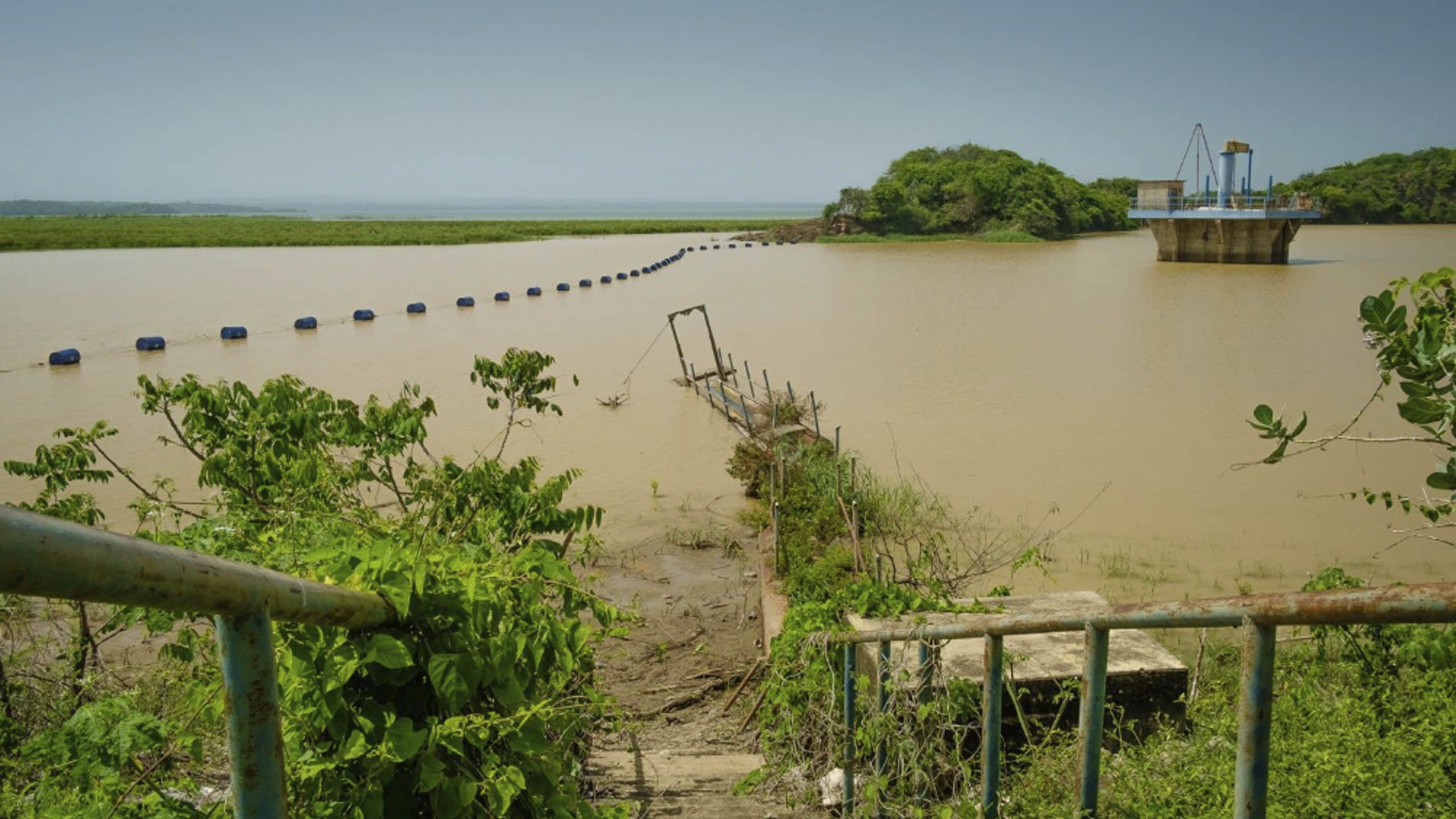
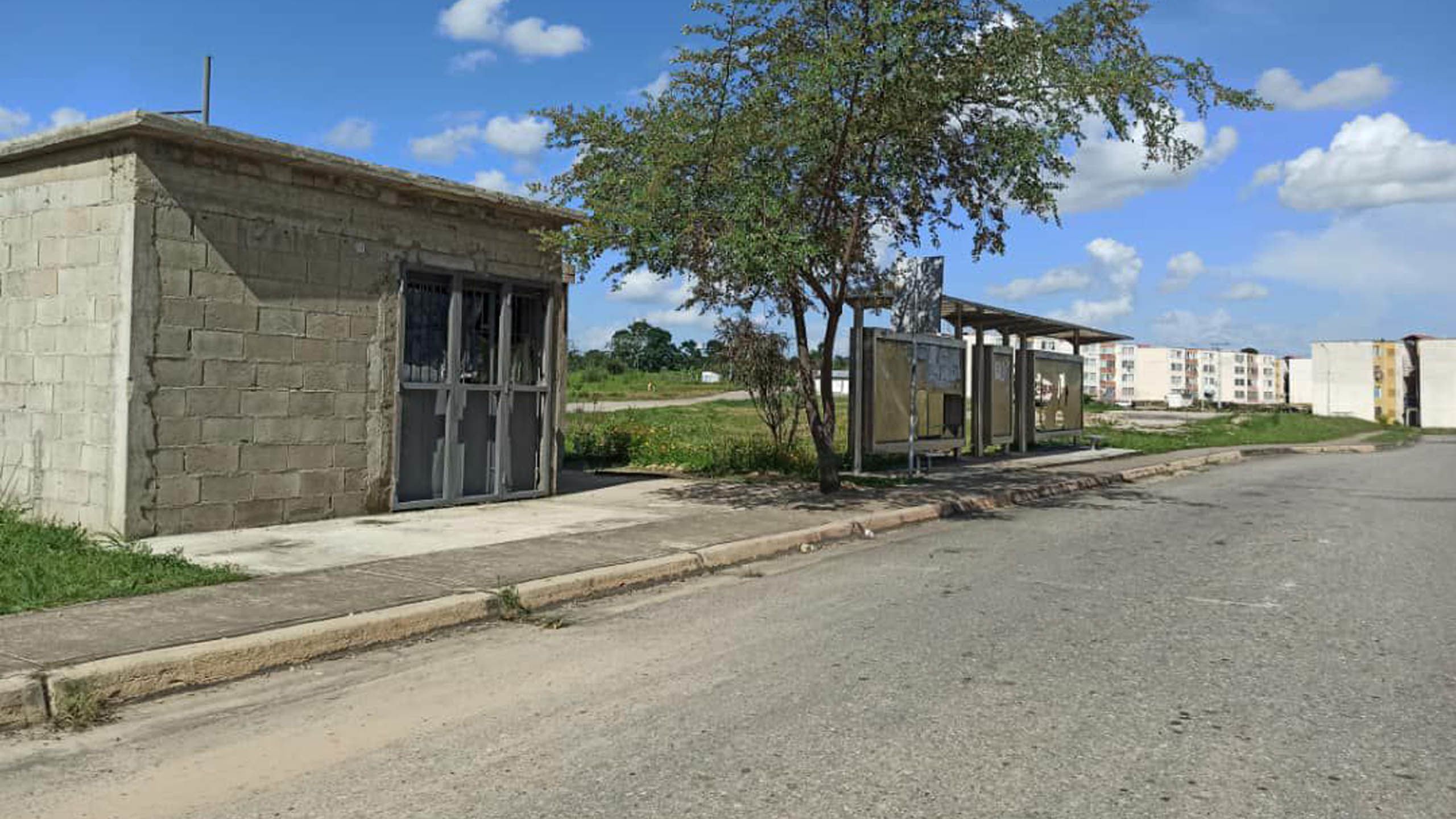





Falcón Bolivarian Aqueduct
Falcón Bolivarian Aqueduct

Tavacare City
Tavacare City

Central-Western Region Railway – Tinaco Anaco
Central-Western Region Railway – Tinaco Anaco

Yutong bus graveyard in Bolívar State
Yutong bus graveyard in Bolívar State

Haier Assembly Plant
Haier Assembly Plant

Delta Amacuro Rice Processing Plant
Delta Amacuro Rice Processing Plant
THE LOSERS

The Falcón Bolivarian Aqueduct was supposed to be the largest aqueduct in Venezuela and was meant to supply 600,000 inhabitants throughout the west with water. 11 years after it began operations, entire communities have no water access. For this reason, Linda Da Carlo, a resident of the La Pastora Bicentennial City, one of the areas where the aqueduct’s pipelines pass through, must go out every week and purchase 1,500 liters of water worth $10.
With a $450 million investment, construction of this water system was given to China Camc Engineering. Set to be completed in 2006, the first phase of the project was delayed for almost a year, generating additional expenses additional expenses, according to the report published by Transparencia Venezuela. In 2007, the office of the Comptroller General of Venezuela stated that there was evidence of irregular management of the funds allocated for the initial works.
The project’s goal was to connect the aqueduct to the Matícora reservoir, one of the largest in Falcón and yet a 1998 engineering study had already warned that the dam would be subject to sedimentation by 2022. In 2009, even President Hugo Chávez stated that the contractor considered the plan to be unviable.
Had the Venezuelan government not improvised during the aqueduct’s construction, the population of Falcón would have had water access. Andrés González, a retired engineer from Hidrofalcón, is certain that the project would have worked if they had followed the technical recommendations given by Hidrofalcón regarding the problem of sedimentation in the Matícora reservoir.
“I only get water for a day and a half. I use everything I can to fill up, but water is so indispensable that it all goes away in a flash”
To date, there is no continuous transfer of water to the Paraguaná Peninsula in Falcón. Nearly 20 holes in the submarine pipeline crossing the Gulf of Coro have been identified by Hidrofalcón.
A field trip made by our team of reporters to the area was able to verify that only three of the eight municipalities included in the project receive water from the Matícora reservoir. Access to it comes every month and a half. This is the same amount of time it takes Linda to see water flow from the taps at home. “I only get water for a day and a half. I use everything I can to fill up, but water is so indispensable that it all goes away in a flash”.
While inhabitants in Falcón wait for constant water supply, residents of Tavacare City, an urban residential project in Barinas built in 2011 with the aid of CITIC Construction Co, Ltd. claim that 5,000 residences have infrastructure damages.
The ARI team visited the buildings and observed that the apartments remained largely unfinished. Floors were not made of granite as originally promised; a great number of apartments have leakages due to inadequate friezing; electric installations do not work properly; and the drainage system is of poor quality.
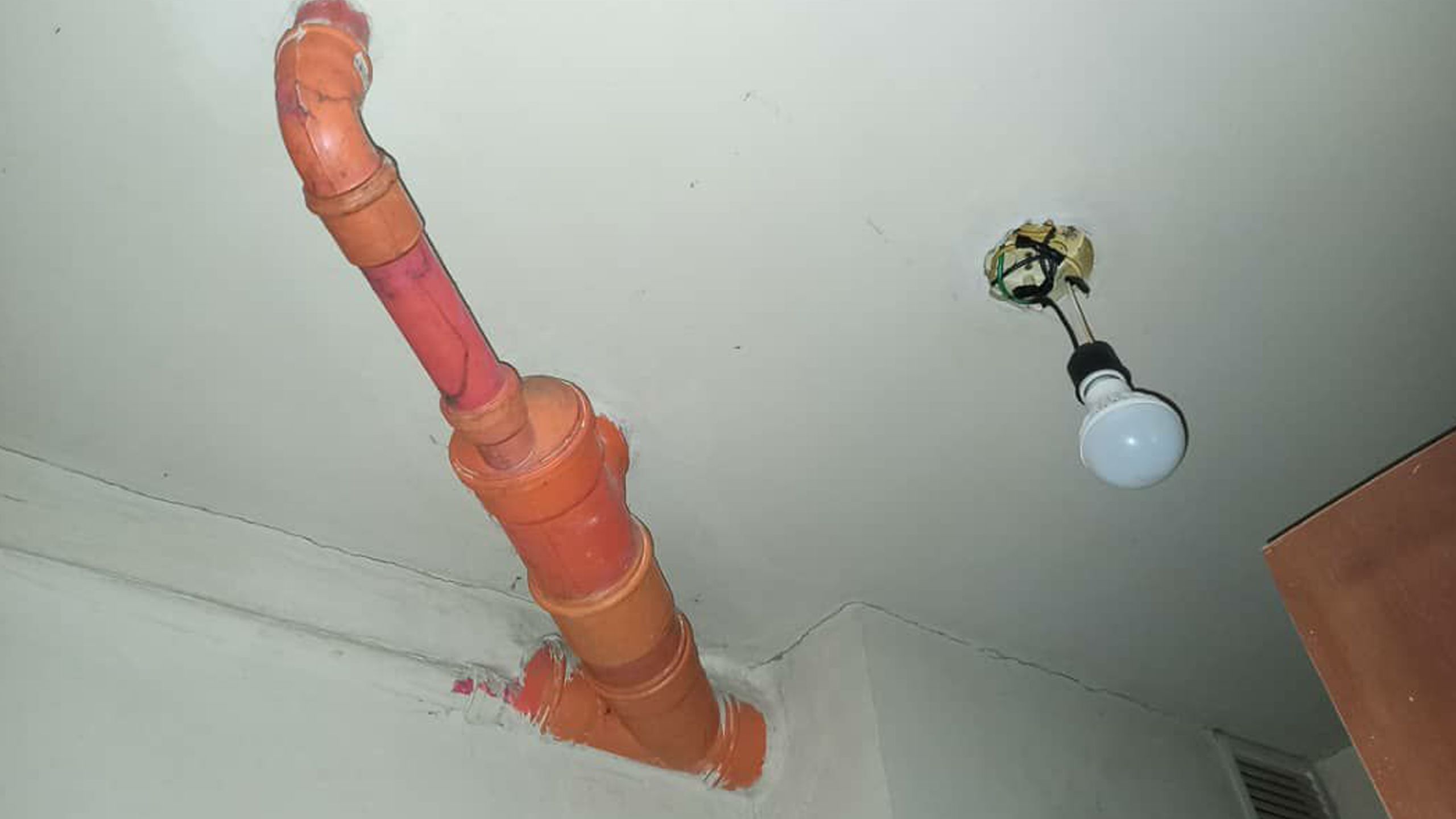




Residents of Tavacare City, an urban residential project located in Barinas and inaugurated in 2011 claimed that their apartments have water leakages and that the electric installation systems do not work properly | Marieva Fermín
Residents of Tavacare City, an urban residential project located in Barinas and inaugurated in 2011 claimed that their apartments have water leakages and that the electric installation systems do not work properly | Marieva Fermín



NEGLECTED INVESTMENTS

344.5 miles from Barinas at Valles del Tuy in Miranda, two Chinese companies, China Railway 9th Group Co. and Henan Tianfon Group, built the Haier Household Appliance Industrial Complex, where refrigerators, washing machines, kitchens and air conditioners were set to be manufactured and sold at affordable prices for low-income Venezuelan families.
Nine years after its doors opened, employees at the factory revealed, under anonymity, that they have only worked on pre-assembled equipment pieces brought in from China. They also revealed that they have never manufactured household appliances, even though the promise was to produce around 815,000 appliances a year. Equipment needed for production, they claim, was never shipped because Venezuela failed to fulfil its debt with China. This is the reason why every Haier product sold in Venezuela is imported.
Workers explained that the absence of a qualified workforce, low income and the lack of equipment testing are just some of the reasons behind the factory’s inoperativeness. “I hoped that the factory would be as good as PDVSA was in its heyday, but it’s been the opposite. The investment was fruitless. They make it seem as if we’re working but we don’t do anything”, says one of the workers.
“I hoped that the factory would be as good as PDVSA was in its heyday, but it’s been the opposite. The investment was fruitless. They make it seem as if we’re working but we don’t do anything”, says one of the workers”
Christi Rangel, from Transparencia Venezuela, points out that China was requested to train the factory workers. However, the Venezuelan government did not invest enough to maintain the project afloat and the Chinese company left.
The lack of qualified workers at the Haier factory is also problematic for Venezuela’s electric power industry. José Aguilar, international consultant in power generation systems, explained that construction companies did train personnel but State companies did not invest in further maintenance work.
Despite constant fluctuations of electricity in Venezuela, the five thermoelectric plants built by China have been shut off. Although these Chinese companies installed 2,359 megawatts to stabilize 40% of the country’s power system, their efforts were in vain. After completion of the public works, neither Corpoelec or PDVSA took proper maintenance measures that would have enabled their future operativity.
The Venezuelan government’s incapacity to uphold investment goals, also affected one project in the transportation sector. The fleet of Yutong buses that the government had bought from China in order to improve public transportation also suffered damages due to lack of maintenance and spare parts. In 2016, the office of the Comptroller General of Venezuela concluded that the Integral System of Land Transportation (SITSSA), a public corporation responsible for these buses, had not employed preventive measures for the maintenance and protection of these vehicles.
The Comptroller’s office was able to verify that 335 transportation units were out of service and parked in seven parking lots belonging to SITSSA. Of the 132 buses inspected, 94 were missing mechanical parts while 12 others, valued at $2.4 million, were dismantled to repair other buses that were operational and breaching the Venezuelan Organic Law of Public Goods. And even though the management office kept records of where every bus was parked, the Comptroller’s office discovered that 26 of them were missing from the “Terminal de Oriente” station in Caracas.
In 2018, the government admitted that 2,000 Yutong buses were out of services due to a lack of spare parts. This represents 28% of the 7,601 vehicles imported by the Venezuelan State. No longer carrying passengers, most of them are parked in 22 scrap metal graveyards. As the ARI team was able to verify, these graveyards have grown substantially since 2015.
The government has announced a plan to recover the fleet with the incorporation of 2,000 new Yutong buses to the public transportation system. To date, there is no certainty about the number of units imported nor their cost. In June 2020, Delcy Rodríguez, Vice President of the Maduro Administration announced the arrival of 1,300 buses to Venezuela, indicating that 812 of them had already begun to be distributed.
That same year, the Yutong factory announced the distribution of 894 public transportation vehicles but did not offer information as to whether they were new or old units. According to available public records, between 2017 and 2021, the Maduro Administration incorporated 2,045 new Yutong buses to the transportation system as a part of their trade agreement with China.
The government also planned to repair 2,000 vehicles that had been out of service since 2018 due to lack of maintenance but did not disclose additional information regarding repairs to those buses that had been dismantled. So far, 1,768 buses had been repaired between 2018 and 2021. According to the government, more than 573 buses were repaired at the Yutong assembly factory, a joint venture between China and Venezuela whose second phase of construction has yet to be completed.
Christi Rangel, regional coordinator of Transparencia Venezuela, blames the Venezuelan government for the failure of these projects and maintains that the National Assembly and the office of the Comptroller General of Venezuela eluded their auditing roles in these cases.
Rangel states that the cabinet ministers in charge of these projects did not follow up on the execution of the works. She adds that the resources allocated by China were not managed in accordance to the standards set by the National Public Credit Office (ONCP). On the contrary, she says, the money was managed by the Venezuelan Economic and Social Development Bank (BANDES).
On September 22, 2021, ARI requested interviews with the current cabinet ministers of Agriculture, Habitat and Housing, Environmental Socialism, Science and Technology; Transportation and Electric Energy, in order to get an official explanation regarding the development and status of these projects. As this report went to press, these requests had not been answered.
Rangel also considers that there has been weakness in the application of the Pubic Procurement Law to State-owned companies or to companies that agree to public works projects within the framework of foreign agreements, as was the case with China.


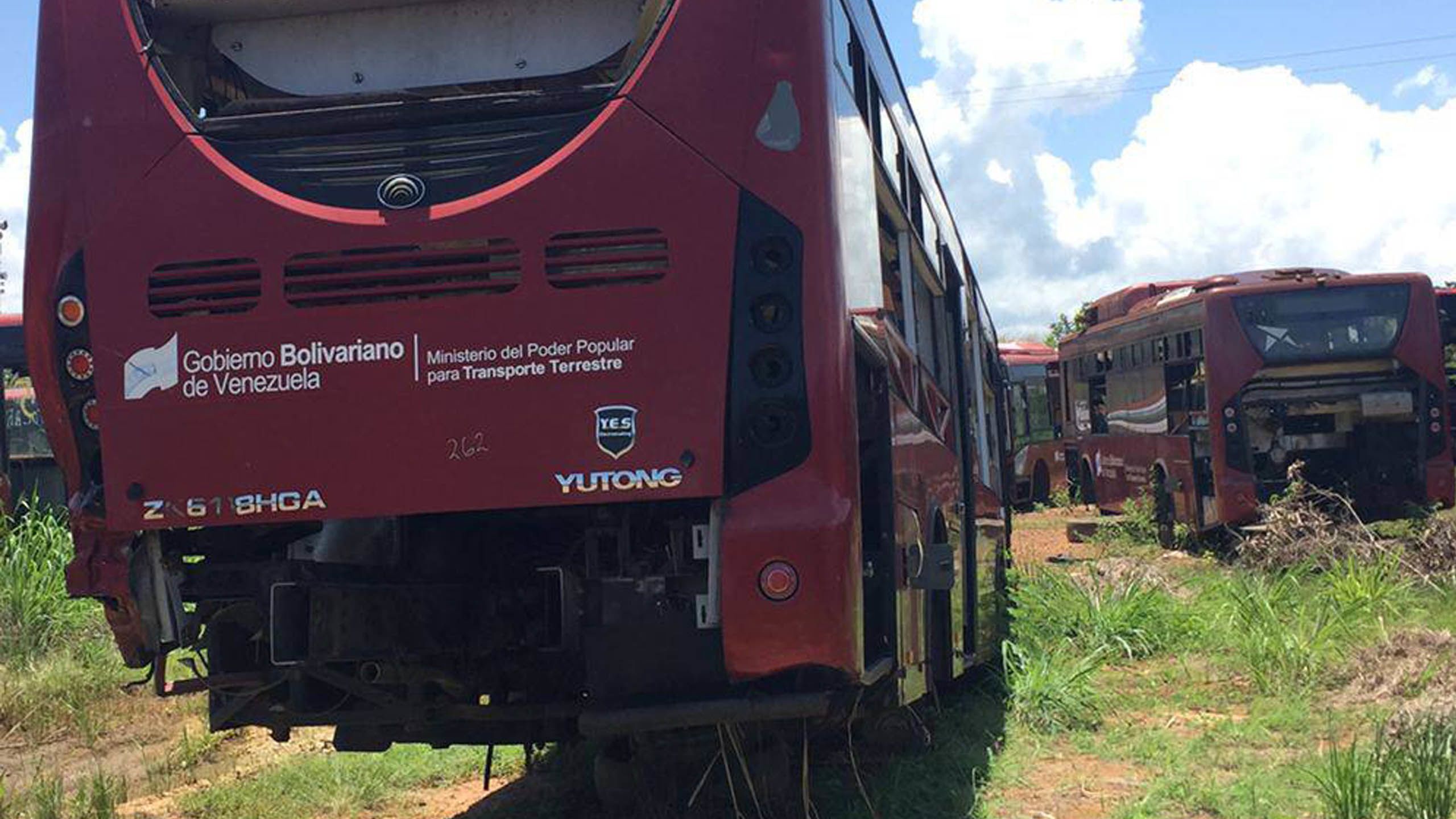

In 2018, the Maduro Administration announced that 2,000 Yutong buses had been repaired. However, by August 2021 there were 22 parking lots with out of service buses across the country. This image shows a Yutong bus graveyard in Bolívar | Carlos Suniaga
In 2018, the Maduro Administration announced that 2,000 Yutong buses had been repaired. However, by August 2021 there were 22 parking lots with out of service buses across the country. This image shows a Yutong bus graveyard in Bolívar | Carlos Suniaga


THE WINNERS

Josefina Cuper, is an indigenous woman from the Warao tribe. She lives close to the Hugo Chávez Rice Processing Plant, located in Delta Amacuro. It’s been two years since it was formally opened and yet neither her or her 10 children have eaten a gram of rice produced by this factory. She feels cheated. “They came here with promises of ending hunger and offering jobs. It was all a lie”, she claims.
The government invested $200 million for the construction of this rice factory whose execution was given to China Camc Engineering. This project intended to produce 20,000 tons of cereal a year. An anonymous source who works in the maintenance department at the plant reveals that this goal has not been reached because the plant currently operates below 40% of its capacity due to lack of resources. The worker says that the plant has been operating below its capacity since it opened in 2019 and it was only in 2020 when it rolled out 5,000 tons, the largest amount of rice it has ever produced. This represents a fourth of what was originally promised.
Facing an unprecedented food crisis in recent years, the Venezuelan population missed out completely on what this rice factory could have produced. As was revealed later on, the winner here turned out to be the Chinese company who managed to obtain a millionaire deal by using fraudulent tactics.
The General Attorney’s Office of Andorra, a European principality, stated that China Camc Engineering paid $100 million in bribes to win the rice plant development contract and €31 million for the construction of the Don Luis Zambrano thermoelectric plant in Merida, according to reports published in 2019 by Reuters news agency and the Spanish newspaper El País.
This alleged fraud caused Andorran authorities to accuse Diego Salazar in 2018. Salazar is a Venezuelan businessman and cousin of the former president of PDVSA, Rafael Ramírez. According to the claim, Salazar had paved the way for this company to win both contracts. A year earlier he had been arrested in Caracas by orders of a city court.
On January 20, 2019, the Public Prosecutor’s Office accused him of committing the crimes of money laundering, passive corruption and conspiracy. According to a report presented by the United Nations Independent International Fact-Finding Mission in Venezuela at the Human Rights Council on September 16, 2021, Salazar has been held in preventive detention under harsh conditions for the past three years.
The Andorra investigation also mentioned Rocío Maneiro, a former Ambassador of Venezuela to China, for having helped Salazar in offering retributions to the Chinese company. However, her fate was different from Salazar’s. She currently serves as the diplomatic envoy of Nicolás Maduro in the United Kingdom. On September 22, 2021, ARI contacted Ms. Maneiro to obtain her version of the story. Via e-mail she replied: “The only lawsuit against Mr. Diego Salazar that I am aware of is the preliminary investigation currently held by the Principality of Andorra; I have not been charged”.
China Camc Engineering also participated in the construction of a 400 kilovolts transmission line between the Manuel Piar plant, known as Tocoma, in Bolívar and the Uribante-Caparo dam in Táchira. According to three former Corpoelec workers tied to the project who spoke under anonymity, the status of this dam is unknown.
“They came here with promises of ending hunger and offering jobs. It was all a lie”
In 2012, Corpoelec and China Camc Engineering signed a $1.3 billion agreement for the installation of the transmission line. Also participating was China Gezhouba Group International Engineering. In 2015, the World Bank announced the debarment of four of its subsidiaries in connection with “misconduct” during the execution of three projects the bank had funded in China that targeted water conservation, earthquake recovery and flood management.
Another company who used the aid of Salazar was the engineering firm Sinohydro Corporation Ltd. who paid him a fee for his help in getting PDVSA to secure them a contract to build the Batalla de Santa Inés, José Félix Ribas and Termocarabobo II power plants in Barinas, Aragua and Carabobo, respectively, at a total price of $2.3 billion. Records at Banca Privada D’Andorra (BPA), a local bank in Andorra, show that the Chinese company transferred $121 million to Salazar’s account after securing the contracts, according to a Reuters report.
The course of the investigations also confirmed that China Machinery Engineering Corporation had been involved in the bribery scam. The company signed a deal for $1.5 billion to install a 600-megawatt turbine at Planta Centro, a thermoplant in Carabobo that was only operational for three years.
The failed projects between Venezuela and China are not only contaminated with briberies as the companies also benefited from overpricing. According to José Aguilar, an engineer and foreign consultant in power generating systems, the Venezuelan government used funds from the Large Volume Long Term Fund to pay China Machinery Engineering Corporation with a 45% surcharge for the Planta Centro turbine.
In the case of the Termocarabobo II power plant, the project cost $1,273,700,000 but according to Aguilar’s estimates, Sinohydro Corporation Ltd. increased the price by $620 million.
Plans for the development of the transportation sector in Venezuela with the aid of China also came at a significant cost for the Venezuelan State. The total investment for the import of 7,061 Yutong buses in 2011 is still unclear.
An investigation set forth by the National Assembly elected in 2015 established that Nicolás Maduro paid close to $1.3 billion for the 7,061 buses. The congressmen concluded that the real price for each bus was $87,000 and yet Venezuela had paid $179,000.
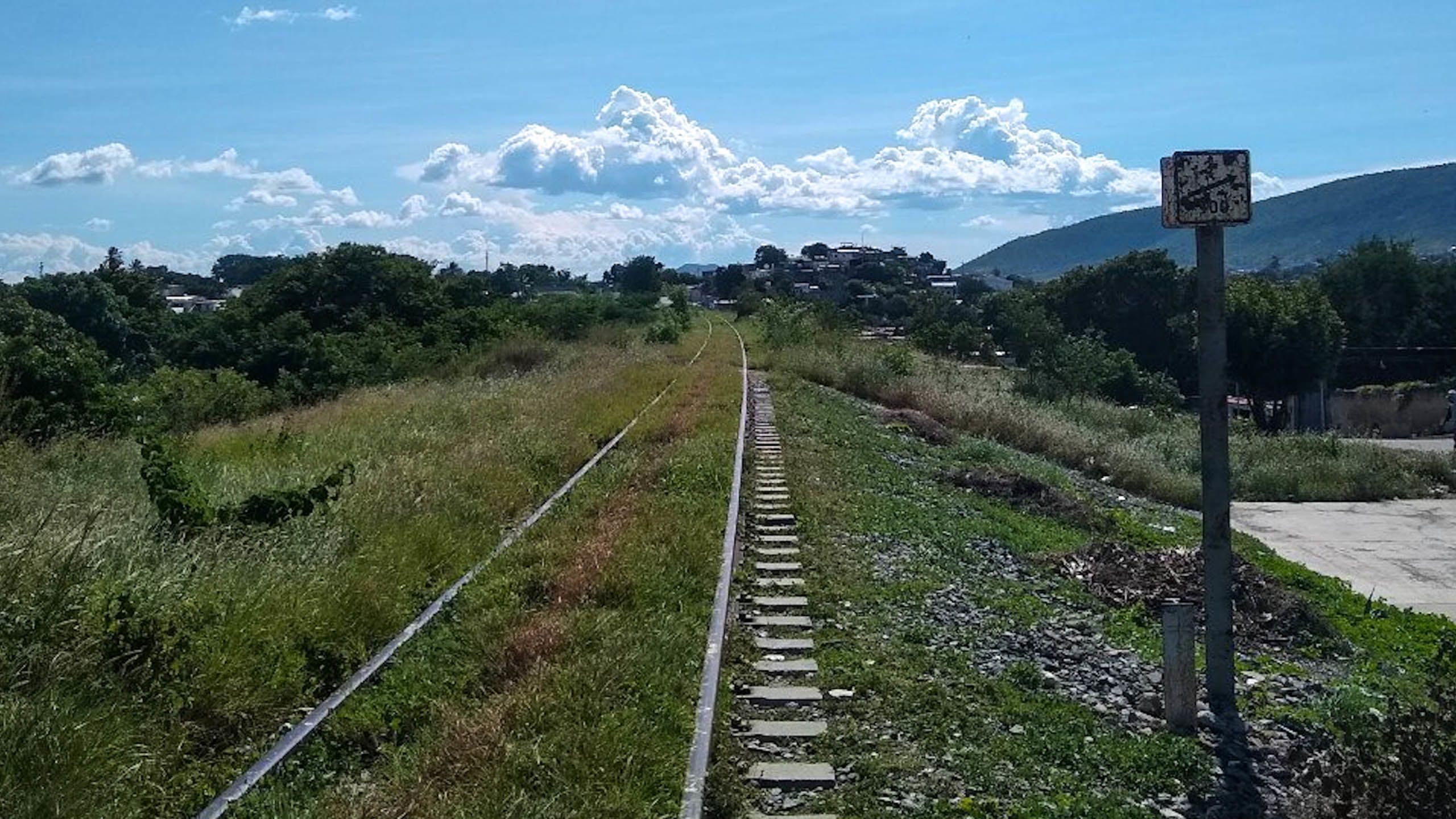


On July 8, 2021, congressman Omar González denounced the dismantlement of the tracks belonging to the future Tinaco-Anaco Railway to be sold as scrap metal. Begun in 2009, it is one of the five development projects whose work has yet to be concluded | Giovanna Pellinani
On July 8, 2021, congressman Omar González denounced the dismantlement of the tracks belonging to the future Tinaco-Anaco Railway to be sold as scrap metal. Begun in 2009, it is one of the five development projects whose work has yet to be concluded | Giovanna Pellinani

In 2004, the Venezuelan government paid $240 million to China’s Yankuang Group Corporation for the rehabilitation of the Simón Bolívar Central-Western Railway system that connects Carabobo, Yaracuy, Lara and Portuguesa. The project was set to be concluded in 2006.
By 2011, after the project was transferred to Infraestructura Ferrioviaria Latinoamericana (Ferrolasa), a joint venture between Cuba and Venezuela, it was estimated that its cost had risen to $871 million, an amount Eduardo Páez Pumar, an engineer, considers excessive for the rehabilitation of a railway.
During the past 17 years the total budget for the rehabilitation of this railway stretch has soared to $2.3 billion. This includes the investment made for the construction of a concrete bridge across the La Ruezga bridge in Lara which also suffered delays until it opened in 2019. A great part of the money came from the Chinese-Venezuelan Fund and the National Development Fund (Fonden). The last resources approved for the stretch were announced in February 2021 when Maduro said he would allocate €579,000 ($695,000) to compete rehabilitation works.
Construction work resumed in 2017, this time managed by workers of the State Railway Institute (IFE) and not private companies, according to the Simón Bolívar Railway System coordinator, Nixón Álvarez. Although the passenger train operates between Lara and Yaracuy and transportation of heavy cargo has been operating normally, the stretch that will carry people from Puerto Cabello, Carabobo to Turén, Portuguesa has yet to be rehabilitated.
On September 22, 2021, ARI sent out interview requests to representatives of every company involved in the development of each of the 17 failed projects. As this report went to press none of the requests had been answered.
The development projects with China, which began during Venezuela’s oil bonanza, never fully covered the needs of the Venezuelan people nor did they solve the specific problems that required striking a deal in the first place. As the nation suffers from an economic crisis, it is difficult to say if these projects will ever be resumed. As Christi Rangel explains, initial investment costs have risen and Venezuela is still in debt with China, making it difficult to seek other funding sources required to reactivate them.
“The problem is that these agreements called for investments that would benefit the greater good and they failed to meet their goals. The agreements placed political and electoral interests, as well as fulfilling populist promises, ahead of solving the problems of the Venezuelan people in the long term”
Rangel adds that further work on these projects would depend on seeking credit investment or other alternative financing mechanisms. In order to do this, she points out, their financial management must be transparent and compliant with its fiscal commitments. “Although we have great debts, we need to renegotiate payment plans and guarantee that there will be greater financial discipline. Failure to do so will translate into lack of funding for these projects and other areas affected by the country’s complex humanitarian emergency”.
Residents in Aragua de Barcelona, Anzoátegui were left with hopes of seeing the train that would pass through the National Railway System’s Tinaco-Anaco line. China Railway Engineering abandoned the project because the Venezuelan government did not pay in time and because the materials required to resume work on the project never arrived.
Today, materials of the stretch that was built, such as rails, railroad ties and other parts, are being dismantled and sold abroad as scrap metal. The National Guard, local residents claim, used to watch over the warehouses, but left when the parts were dismantled.
The desolate grounds of the Batalla de Santa Inés refinery are similar to those in Aragua de Barcelona, where the parallel lines that would serve as guides to lay the railroad tracks are still marked on the land surface. Its former workers, all locals from this town in Anzoátegui , look forward to its reactivation because they know that this is an important service that would give them much needed work during these times of crisis. Besides, they claim, failure to work on the project would mean losing the progress that has already been achieved.
If Venezuela’s failed development plans with China have something in common is that the government failed to act upon the Nation’s best interests by not even ensuring a maintenance plan for those projects that were able to be completed.
Regarding this situation, Transparencia Venezuela’s regional coordinator Christi Rangel concludes: “The problem is that these agreements called for investments that would benefit the greater good and they failed to meet their goals. The agreements placed political and electoral interests, as well as fulfilling populist promises, ahead of solving the problems of the Venezuelan people in the long term”.
And this is how the Venezuelan government mismanaged and apparently lost $22 billion, a sum that would have benefited a population who suffers from power cuts on a daily basis and has no stable access to public transportation. Venezuela became a country with a paralyzed industry where job opportunities are scarce. Had these 17 projects not failed, the national panorama would have been, without a doubt, completely different for the Venezuelan people.
CREDITS
Editor-in-Chief: Grisha Vera
Reporters: Armando Altuve - Patzzy Salazar - Nataly Angulo - Sheyla Urdaneta - Daniel Benitez - Grisha Vera
Editing: César Batiz - Loly Áñez
Design: Antonio Ramón Hernández - Elsy Torres
Graphic Layouts: Abrahan Moncada - Antonio Ramón Hernández
Photography: Francisco Chirinos - Marieva Fermín - Carlos Suniaga - Giovanna Pellicani - Liz Gascón - Rosanna Batistelli - Melquiadez Ávila - Carlos García - Oficina Regional de Información de Falcón
Field Reporting: Carlos Suniaga - Mickey Véliz - Melquiades Ávila - Rosanna Batistelli - Ruth Lara Castillo - Nadeska Noriega - Francisco Chirinos - Jesymar Áñez - Marinelid Marcano - Giovanna Pellicani - Yesenia García - Bianile Rivas - Marieva Fermín - Alexander Olvera - Pedro Izzo - María Eugenia Díaz - Keren Torres - Liz Gascón - Irene Revilla - Johana Prieto - María Fernanda Rodríguez - Lorena Bonacelly - Mariana Duque - María Danieri - Lisbeth Barboza - Mariángel Moro Colmenárez
Editor-in-Chief: Alianza Rebelde Investiga (ARI): Lisseth Boon
With the editorial participation and multimedia by: CONNECTAS Team
SEPTEMBER 2021
